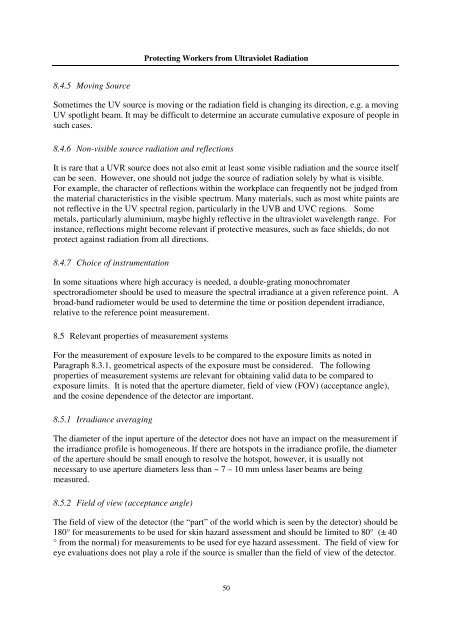Protecting Workers from Ultraviolet Radiation - icnirp
Protecting Workers from Ultraviolet Radiation - icnirp
Protecting Workers from Ultraviolet Radiation - icnirp
Create successful ePaper yourself
Turn your PDF publications into a flip-book with our unique Google optimized e-Paper software.
8.4.5 Moving Source<br />
<strong>Protecting</strong> <strong>Workers</strong> <strong>from</strong> <strong>Ultraviolet</strong> <strong>Radiation</strong><br />
Sometimes the UV source is moving or the radiation field is changing its direction, e.g. a moving<br />
UV spotlight beam. It may be difficult to determine an accurate cumulative exposure of people in<br />
such cases.<br />
8.4.6 Non-visible source radiation and reflections<br />
It is rare that a UVR source does not also emit at least some visible radiation and the source itself<br />
can be seen. However, one should not judge the source of radiation solely by what is visible.<br />
For example, the character of reflections within the workplace can frequently not be judged <strong>from</strong><br />
the material characteristics in the visible spectrum. Many materials, such as most white paints are<br />
not reflective in the UV spectral region, particularly in the UVB and UVC regions. Some<br />
metals, particularly aluminium, maybe highly reflective in the ultraviolet wavelength range. For<br />
instance, reflections might become relevant if protective measures, such as face shields, do not<br />
protect against radiation <strong>from</strong> all directions.<br />
8.4.7 Choice of instrumentation<br />
In some situations where high accuracy is needed, a double-grating monochromater<br />
spectroradiometer should be used to measure the spectral irradiance at a given reference point. A<br />
broad-band radiometer would be used to determine the time or position dependent irradiance,<br />
relative to the reference point measurement.<br />
8.5 Relevant properties of measurement systems<br />
For the measurement of exposure levels to be compared to the exposure limits as noted in<br />
Paragraph 8.3.1, geometrical aspects of the exposure must be considered. The following<br />
properties of measurement systems are relevant for obtaining valid data to be compared to<br />
exposure limits. It is noted that the aperture diameter, field of view (FOV) (acceptance angle),<br />
and the cosine dependence of the detector are important.<br />
8.5.1 Irradiance averaging<br />
The diameter of the input aperture of the detector does not have an impact on the measurement if<br />
the irradiance profile is homogeneous. If there are hotspots in the irradiance profile, the diameter<br />
of the aperture should be small enough to resolve the hotspot, however, it is usually not<br />
necessary to use aperture diameters less than ~ 7 – 10 mm unless laser beams are being<br />
measured.<br />
8.5.2 Field of view (acceptance angle)<br />
The field of view of the detector (the “part” of the world which is seen by the detector) should be<br />
180° for measurements to be used for skin hazard assessment and should be limited to 80° (± 40<br />
° <strong>from</strong> the normal) for measurements to be used for eye hazard assessment. The field of view for<br />
eye evaluations does not play a role if the source is smaller than the field of view of the detector.<br />
50



